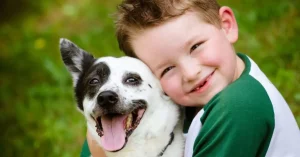Steering through the loss of a beloved dog can be particularly challenging for children. Parents often struggle with how to broach the topic of euthanasia. Insightful podcast conversations offer guidance on this sensitive matter. They emphasize creating a supportive environment, using appropriate language, and validating children’s feelings. Understanding these elements can help parents foster emotional healing. Yet, many questions remain about how to effectively support a child through this profound experience—including how to talk to children about dog euthanasia in a way that is honest, gentle, and age-appropriate.
Key Takeaways
- Discuss your own emotions to prepare for a compassionate conversation about euthanasia with your child.
- Create a comfortable environment to encourage open dialogue and expression of feelings.
- Use age-appropriate language to explain the concepts of illness and death gently.
- Validate your child’s emotions, providing a safe space for them to ask questions and share feelings.
- Utilize resources such as books and support groups to guide discussions and emotional processing.
Understanding the Impact of Dog Loss on Children
Losing a beloved dog can profoundly affect children, often leaving them grappling with complex emotions. The loss can evoke feelings of sadness, confusion, and even guilt. Children may struggle to understand why their furry friend is no longer present, leading to questions that parents may find challenging to answer. This grief can manifest in various ways, such as changes in behavior, withdrawal from social activities, or heightened anxiety. It is essential for parents to recognize these reactions and create an environment where children feel safe expressing their feelings. Open discussions about love, loss, and memories can help children process their emotions, fostering resilience and a sense of belonging in their family unit as they navigate this difficult experience.
Preparing for the Conversation: Key Considerations
Steering through the delicate topic of dog euthanasia requires careful preparation, especially when addressing children. Parents should first reflect on their own emotions, as their reactions can notably influence how children perceive the situation. Creating a safe and comfortable environment for the conversation is essential, allowing children to express their feelings openly. It’s important for parents to reflect on the child’s relationship with the dog, as well as their developmental stage, to gauge how to approach the discussion. Parents should also anticipate potential questions and be ready with honest, age-appropriate answers. By preparing thoughtfully, parents can foster a supportive dialogue, helping children navigate their emotions and understand the concept of loss in a compassionate manner.

Age-Appropriate Language and Concepts
When discussing dog euthanasia, using age-appropriate language and concepts is essential to help children grasp the situation without causing additional distress. For younger children, simple explanations about illness and the need for relief can be comforting. Phrases like “going to sleep” can provide a gentle understanding, while avoiding graphic details. As children grow older, they can comprehend more complex concepts about life and death, allowing for deeper discussions about compassion and the cycle of life. It’s vital to encourage questions and validate their feelings, ensuring they feel supported. By tailoring the conversation to their developmental stage, parents can foster a safe space for children to express their emotions and thoughts on this sensitive topic.
Emotional Support During the Euthanasia Process
As families navigate the difficult decision of dog euthanasia, providing emotional support becomes essential for children who may be struggling to understand the situation. This can be a challenging time, and parents should endeavor to create a space where children feel safe expressing their feelings.
To support children emotionally during this process, consider the following:
- Encourage open dialogue: Allow children to ask questions and share their emotions without judgment.
- Validate their feelings: Recognize that sadness, confusion, or even anger are normal responses.
- Create lasting memories: Engage in activities that honor the pet’s life, such as a memory box or a farewell ceremony.
Resources for Parents: Books and Support Groups
Maneuvering the emotional landscape of dog euthanasia can be particularly intimidating for parents, especially when children are involved. To aid in these challenging conversations, numerous resources are available. Books such as “Goodbye, Friend: Healing Wisdom for Anyone Who Has Ever Lost a Pet” provide gentle guidance on steering through grief and loss. Support groups, both online and in-person, offer a sense of community where parents can share experiences and seek advice. Organizations like the ASPCA often host workshops and provide literature aimed at helping families understand how to talk to children about dog euthanasia. These resources can empower parents, fostering a supportive environment where both parents and children can process their emotions together.
Frequently Asked Questions
What Signs Indicate My Child Is Struggling With Grief?
Signs of a child struggling with grief may include withdrawal from activities, changes in sleep or appetite, increased irritability, frequent crying, and difficulty concentrating. Recognizing these signs allows caregivers to provide the necessary support and understanding.
How Can I Help My Child Remember Our Dog Positively?
To help a child remember their dog positively, encourage storytelling about joyful moments, create a memory box with favorite toys, and celebrate the dog’s life through drawings and shared memories, fostering connection and healing.
Should I Involve My Child in the Decision-Making Process?
Involving a child in the decision-making process can foster a sense of agency and understanding. It allows them to express feelings, learn empathy, and create lasting memories, ultimately helping them cope with the situation more positively.
What Activities Can Help My Child Cope After Euthanasia?
After euthanasia, engaging in creative activities like drawing or writing can help children express their feelings. Additionally, sharing memories through storytelling or creating a memory box fosters connection, encouraging healing and comfort during this difficult time.
How Do I Address My Child’s Questions About Death?
Addressing a child’s questions about death requires patience and honesty. Providing clear, age-appropriate explanations and encouraging open dialogue fosters understanding, helping them process their feelings and find comfort in shared experiences and support from loved ones.
Conclusion
Steering the conversation about dog euthanasia with children is a delicate yet essential task for parents. By fostering an open environment, using language that resonates with their child’s understanding, and providing emotional support, parents can help their children process their grief. Emphasizing the importance of honoring the pet’s memory and seeking additional resources can further aid in this journey. Ultimately, these discussions can strengthen familial bonds and promote emotional healing in the face of loss.
You May Also Like To Read:


